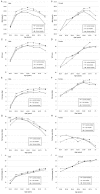Age plays an important role in the relationship between smoking status and obesity risk: a large scale cross-sectional study of Chinese adults
- PMID: 26770514
- PMCID: PMC4694414
Age plays an important role in the relationship between smoking status and obesity risk: a large scale cross-sectional study of Chinese adults
Abstract
Objective: To study the role of age plays in the relationship between smoking status and obesity in both Chinese men and women.
Methods: From Chinese Physical and Psychological Database, participants were divided into non-smokers, current smokers, and former smokers. Body mass index (BMI), waist circumference (WC), fat percentage, fat mass, and fat free mass were measured. The mean, standard deviation and frequency of these indicators were calculated for each age bracket. One-way ANOVA and post-hoc test analyses were used to detect the difference among these three groups.
Results: In men, from 19 to 24 years old, BMI, WC and fat free mass of current smokers were higher than that of non-smokers (P<0.01). However, fat mass and fat percentage of current smokers were lower than that of non-smokers but higher than that of former smokers (P<0.01). From 25 to 34 years old, BMI and fat mass of former smokers were higher than non-smokers and current smokers (P<0.01). In addition, WC and fat free mass of non-smokers were lower than that of current smokers and former smokers (P<0.01). From 45 to older, BMI, WC, fat mass, fat free mass and fat percentage of former smokers were higher than that of current smokers (P<0.01). From 55 to older, BMI, WC, fat mass, fat free mass and fat percentage of current smokers were lower than that of non-smokers (P<0.01). In women, smoking status might not be significantly related to obesity (P>0.05).
Conclusion: For young men, smoking might have an effect on increasing fat free mass, BMI and WC, and decreasing fat mass and fat percentage. For middle and older men, smoking might have an effect on decreasing fat free mass, fat mass, BMI, WC, and fat percentage. Obesity risk should be paid more attention in smoking cessation programs for those former smokers.
Keywords: Smoking; fat percentage; obesity.
Figures

Similar articles
-
Associations of tobacco smoking with body mass distribution; a population-based study of 65,875 men and women in midlife.BMC Public Health. 2019 Nov 1;19(1):1439. doi: 10.1186/s12889-019-7807-9. BMC Public Health. 2019. PMID: 31675936 Free PMC article.
-
[Gender difference in association between smoking and metabolic risks among community adults].Zhonghua Yi Xue Za Zhi. 2011 Mar 29;91(12):805-9. Zhonghua Yi Xue Za Zhi. 2011. PMID: 21600158 Chinese.
-
Associations of nicotine dependence and fat distribution in Chinese male adults: a cross-sectional study in Lanxi, China.BMJ Open. 2019 Mar 12;9(3):e022465. doi: 10.1136/bmjopen-2018-022465. BMJ Open. 2019. PMID: 30862630 Free PMC article.
-
The relationship between physical activity, obesity, and lung cancer risk by smoking status in a large prospective cohort of US adults.Cancer Causes Control. 2017 Dec;28(12):1357-1368. doi: 10.1007/s10552-017-0949-0. Epub 2017 Sep 22. Cancer Causes Control. 2017. PMID: 28940119
-
Relationship Between Intraocular Pressure and Parameters of Obesity in Korean Adults: The 2008-2010 Korea National Health and Nutrition Examination Survey.Curr Eye Res. 2015;40(10):1008-17. doi: 10.3109/02713683.2014.975367. Epub 2014 Nov 7. Curr Eye Res. 2015. PMID: 25380054
Cited by
-
Cigarette Smoking Is Negatively Associated with the Prevalence of Type 2 Diabetes in Middle-Aged Men with Normal Weight but Positively Associated with Stroke in Men.J Diabetes Res. 2019 Sep 11;2019:1853018. doi: 10.1155/2019/1853018. eCollection 2019. J Diabetes Res. 2019. PMID: 31612146 Free PMC article.
-
Prognostic impact of body mass index stratified by smoking status in patients with esophageal squamous cell carcinoma.Onco Targets Ther. 2016 Oct 17;9:6389-6397. doi: 10.2147/OTT.S111843. eCollection 2016. Onco Targets Ther. 2016. PMID: 27799787 Free PMC article.
-
Hematocrit Values Predict Carotid Intimal-Media Thickness in Obese Patients With Non-Alcoholic Fatty Liver Disease: A Cross-Sectional Study.Front Endocrinol (Lausanne). 2018 Apr 30;9:203. doi: 10.3389/fendo.2018.00203. eCollection 2018. Front Endocrinol (Lausanne). 2018. PMID: 29760679 Free PMC article.
References
-
- WHO. Obesity and overweight. WHO Media centre; 2015.
-
- Mejia-Benitez MA, Bonnefond A, Yengo L, Huyvaert M, Dechaume A, Peralta-Romero J, Klunder-Klunder M, Garcia Mena J, El-Sayed Moustafa JS, Falchi M, Cruz M, Froguel P. Beneficial effect of a high number of copies of salivary amylase AMY1 gene on obesity risk in Mexican children. Diabetologia. 2015;58:290–294. - PubMed
-
- St-Pierre J, Poirier P. What nature used to allow to die, don’t let modern habits damage after repair: preventable obesity risk in congenital heart disease. Can J Cardiol. 2015;31:109–111. - PubMed
-
- Ochner CN, Tsai AG, Kushner RF, Wadden TA. Treating obesity seriously: when recommendations for lifestyle change confront biological adaptations. Lancet Diabetes Endocrinol. 2015;3:232–4. - PubMed
LinkOut - more resources
Full Text Sources
